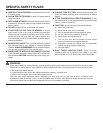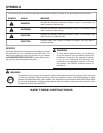
4
SPECIFIC SAFETY RULES
GENERAL SAFETY RULES
INSPECT TOOL CORDS PERIODICALLY. If dam-
aged, have repaired by a qualified service technician at
an authorized service facility. The conductor with insulation
having an outer surface that is green with or without yellow
stripes is the equipment-grounding conductor. If repair
or replacement of the electric cord or plug is necessary,
do not connect the equipment-grounding conductor to a
live terminal. Repair or replace a damaged or worn cord
immediately. Stay constantly aware of cord location and
keep it well away from the rotating blade.
INSPECT EXTENSION CORDS PERIODICALLY and
replace if damaged.
GROUND ALL TOOLS. If tool is equipped with three-
prong plug, it should be plugged into a three-hole
electrical receptacle.
CHECK WITH A QUALIFIED ELECTRICIAN or service
personnel if the grounding instructions are not completely
understood or if in doubt as to whether the tool is properly
grounded.
USE ONLY CORRECT ELECTRICAL DEVICES: 3-wire
extension cords that have 3-prong grounding plugs and
3-pole receptacles that accept the tool’s plug.
DO NOT MODIFY the plug provided. If it will not fit the
outlet, have the proper outlet installed by a qualified
electrician.
KEEP TOOL DRY, CLEAN, AND FREE FROM OIL AND
GREASE. Always use a clean cloth when cleaning. Never
use brake fluids, gasoline, petroleum-based products, or
any solvents to clean tool.
STAY ALERT AND EXERCISE CONTROL. Watch what
you are doing and use common sense. Do not operate
tool when you are tired. Do not rush.
DO NOT USE TOOL IF SWITCH DOES NOT TURN IT
ON AND OFF. Have defective switches replaced by an
authorized service center.
NEVER TOUCH BLADE or other moving parts during
use.
NEVER START A TOOL WHEN ANY ROTATING
COMPONENT IS IN CONTACT WITH THE
WORKPIECE.
DO NOT OPERATE A TOOL WHILE UNDER THE
INFLUENCE OF DRUGS, ALCOHOL, OR ANY
MEDICATION.
WHEN SERVICING use only identical replacement parts.
Use of any other parts may create a hazard or cause
product damage.
USE ONLY RECOMMENDED ACCESSORIES listed
in this manual or addendums. Use of accessories that
are not listed may cause the risk of personal injury.
Instructions for safe use of accessories are included
with the accessory.
DOUBLE CHECK ALL SETUPS. Make sure blade is tight
and not making contact with tool or workpiece before
connecting to power supply.
NEVER PERFORM THE PLANING OPERATION with
the cutterhead or dust hood removed.
NEVER MAKE A PLANING CUT deeper than 1/8 in.
DO NOT PLANE MATERIAL shorter than 14 in. or
narrower than 3/4 in.
MAINTAIN THE PROPER RELATIONSHIP between the
infeed and outfeed surfaces and the cutterhead blade
path.
SUPPORT THE WORKPIECE ADEQUATELY at all
times during operation; maintain control of the work at
all times.
NEVER FEED THE WORK from the rear of the planer.
DO NOT ATTEMPT TO PERFORM an abnormal or little
used operation without the use of sturdy and adequate
jigs, fixtures, stops, and the like.
NEVER plane more than one piece at a time. DO NOT
PLANE more than one workpiece on the planer table at
a time.
BEFORE STARTING UP, recheck to make certain all
holding screws are tight.
STOP THE MACHINE and recheck the hex head bolts
and blades for tightness after about 50 hours of opera-
tion.
DO NOT FORCE FEED THE WORKPIECE through the
machine. Let the planer apply the proper feed rate.
CHECK THE FEED ROLLERS occasionally to be sure
there are no chips or sawdust between any compo-
nents.
PLANE ONLY SOUND LUMBER; there should be no
loose knots and as few tight knots as possible. Make sure
the workpiece is free from nails, screws, stones, or other
foreign objects that could break or chip the blades.
NEVER STAND DIRECTLY IN LINE with either the infeed
or outfeed sides. Stand off to one side.
MAKE SURE THE BLADES ARE ATTACHED as described
in the operation section. The blades are sharp and can
easily cut your hand. Use caution in handling the blades
and cutterhead guard.


















